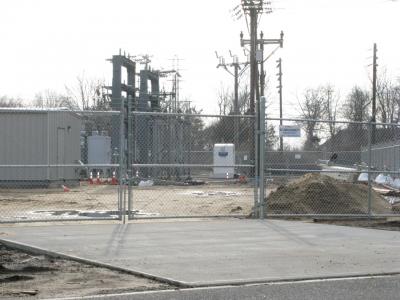Judge Lifts PSEG Stop-Work Order in Gansett

A Supreme Court judge ruled Thursday that PSEG Long Island, an electrical energy provider, and the Long Island Power Authority, for which PSEG is a contractor, are not subject to local zoning and other laws.
The ruling clears the way for PSEG to finish work at an Amagansett electrical transmission substation, the only thing left before new, high-voltage transmission lines that have caused consternation among residents of neighborhoods along their route can go online.
PSEG had challenged the authority of East Hampton Town to require a site plan for changes at the substation, which the company was upgrading for high-voltage line use.
Last April the town ordered a stop to the work at the substation, at the foot of Old Stone Highway adjacent to the Long Island Rail Road station, but not before the site and its surroundings had been cleared of screening vegetation, a building erected, and a chain-link fence installed.
The town claimed that a building permit and site plan approval were needed for the work, while PSEG argued that the company was exempt from those requirements.
The installation by PSEG of high-voltage lines on poles larger than those they replaced along a six-mile route from an East Hampton Village substation to the Amagansett site caused an outcry from residents who asked to have the lines installed underground, and is the subject of ongoing litigation by a private group against PSEG.
PSEG officials said they would bury the lines, but only if East Hampton residents shouldered the entire cost, estimated at $25 million. Cost-sharing scenarios, such as one that was effected when LIPA buried electric lines in Southampton Town, were suggested, but discussions between the company and East End local and state officials broke down.
Residents have cited concern for the proximity of high-voltage wires and poles coated with pentachlorophenol, a toxic chemical, to their houses, with potential impacts to their health and safety as well as to property values.
In the ruling issued last week, State Supreme Court Justicee Thomas F. Whelan nullified the stop-work order and said that LIPA and PSEG are "exempt from the application or enforcement of any local laws, regulations, rules and/or ordinances that would otherwise govern the construction and maintenance of the LIPA transmission and distribution system."
Under the LIPA Reform Act, PSEG was designated as LIPA's service provider, with "complete operations and maintenance responsibilities for LIPA's electric transmission and distribution system," Judge Whelan wrote. LIPA, he said, "is an agency of the State of New York," under the Public Authorities Law, and therefore granted the power to construct power generating or transmission facilities without local approval.
In its court filing, PSEG claimed that LIPA had not filed for a municipal building permit for any substation project since January 2001, and noted that the project received approval from the state's Department of Public Service, the agency charged with overseeing LIPA, in order to increase the reliability of the electric system by providing a secondary, or "redundant," system to supply electricity in case of a power line failure.
Two-hundred sixty-seven replacement poles have been installed and 23 and 33-kilovolt lines strung from LIPA's Buell Lane, East Hampton, substation, through East Hampton Village, and along Town Lane to Old Stone Highway to reach the Amagansett substation.
